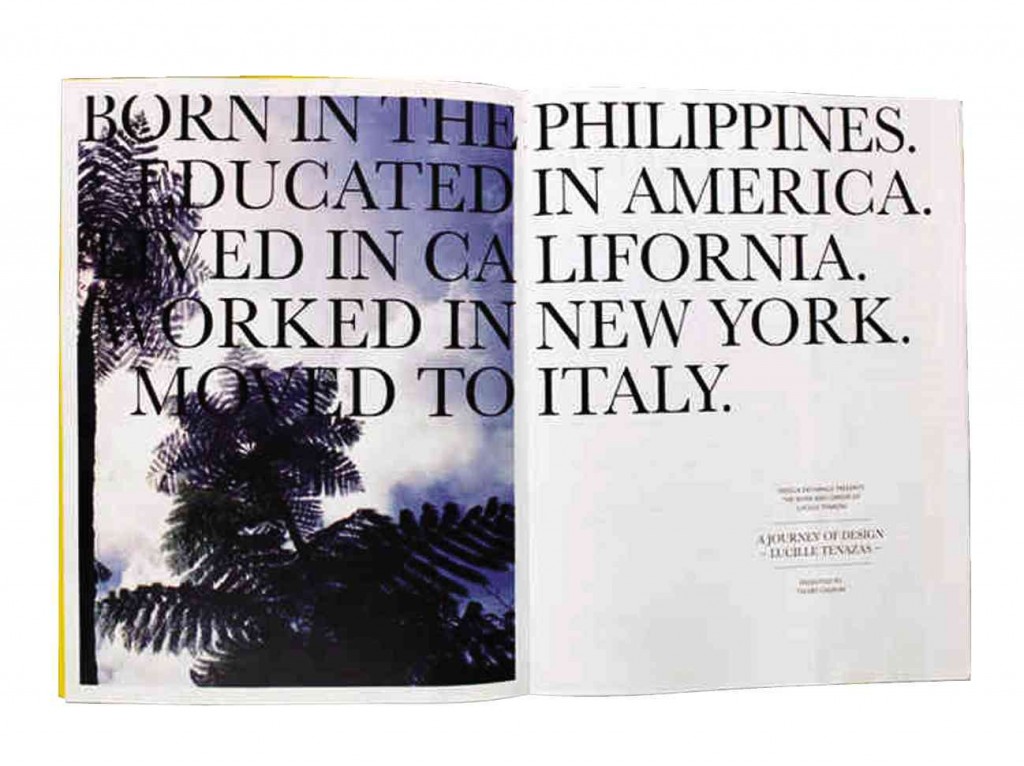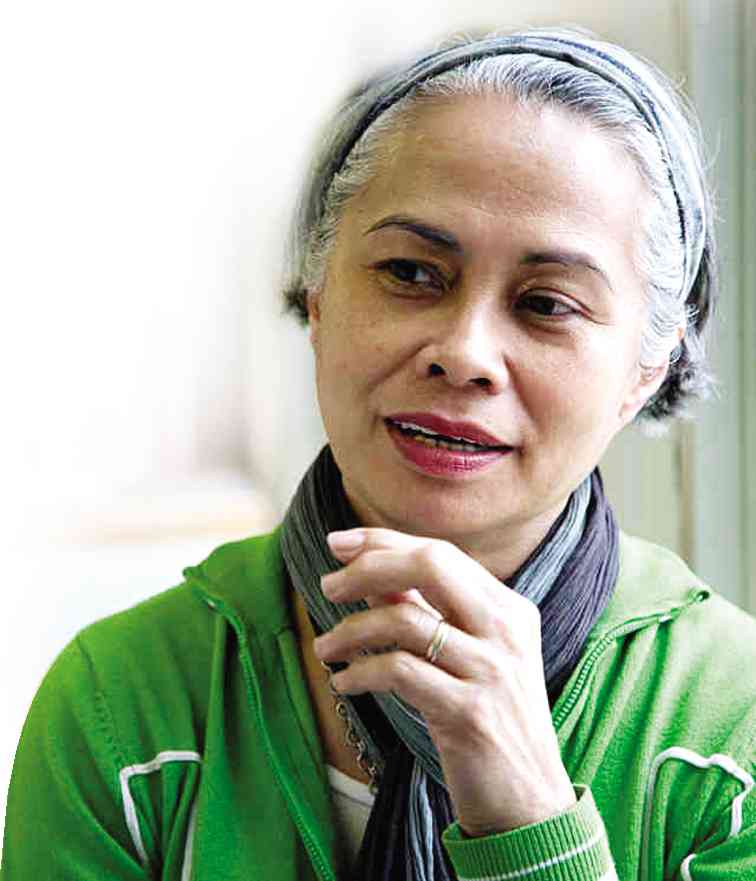Filipino woman graphic designer the world respects

CULTURAL NOMAD Lucille Tenazas was interviewed by Debbie Tillman in her book titled “How to Think Like a Great Graphic Designer.”
Lucille Tenazas’ body of work makes you think it was made by some Brazilian or European designer, or a young geek, all-tattooed, hip, with a headphone forever strapped on the head that created it.
Behind the misnomer, is a lady way past her prime by Philippine standards but who cares? She has conquered America, is respected in Europe and still conquering the world.
But first, Lucille Tenazas who?
Award-winning creative director without the fancy adjective attached to it, designer par excellence, educator, graduate of one of America’s best art schools, New York professor and associate dean, owner of a hothouse for impeccable design. And that is just the tip of the iceberg.
No age barrier
She was in town recently to bestow the Tenazas Excellence Award in a design competition and conduct a master class for Philippine graphic designers.
She exemplifies talent that has no age barrier. The older she gets, the better she gets. The moment you see Tenazas, you would conclude that she is just 18, bubbly, energetic and raring to take design to a new dimension.
Job chooses you
On “Be interested in others” blog, the author mentions: “She’s been designing for over 30 years but she’s still really hip.” Another, (OnePaisley) quotes her favorite line to her underlings: “Will your work excite you just the same in 50 years?”
Who would have thought that a Filipino woman would be chosen one of America’s best 40 design innovators and that the San Francisco Museum of Modern Art and Ayala Museum in Manila would exhibit retrospectives of her work?
In an exclusive interview for GlobalPinoy, Tenazas says: “A profession chooses you, you don’t choose it.”
Talent, hard work
Tenazas did not become a highly respected designer by accident. She has an in-born talent and worked hard on her craft when sophisticated computers, a convenient artwork-rendering machine of today’s designers, still did not exist.
At an early age, she already showed signs of giftedness. When she was 10 years old, she would gladly volunteer to do school assignments for her siblings. At their family dining table, she would hurriedly clean it dry to make it her instant working area—sketching objects, palm trees and faces down to their littlest details.
Tenazas belonged to a relatively large family. Her civil engineer father sent all her brothers and sisters, including an aunt, to college.
Collegiate competitions
At Holy Spirit School of Fine Arts in Mendiola, she enrolled under talented instructors to further hone her talent. Then she kept winning collegiate art contests and even topped national on-the spot-painting competitions participated by students from all over the Philippines.
Right after college, she was immediately hired by two pharmaceutical companies as a graphic designer. By that time, too, her aunt had made good as a doctor and settled in Michigan.
“When my father died, my aunt whom my father also sent to college, wanted to return the favor. She invited me to come over and explore possibilities of taking postgraduate work in the US.”
When she landed in Michigan, Tenazas knocked on the door of a school right in the neighborhood of her aunt’s house. It was Cranbrook Academy of Art, the same prestigious school two Philippine national artists (the late Jose Joya and Napoleon Abueva) attended years back.
Not an easy life
Tenazas attempted to enroll but much to her disdain, was rejected time and again. “They probably thought my work wasn’t too western and not sophisticated enough,” she recalls. She didn’t give up and instead, headed westward and eventually took courses at California College of Arts (CCA) in San Francisco.
Here, Tenazas would absorb many design genres under the famous Michael Vanderbyl and other California design educators whose approach bordered on the new wave and colorful experimentations.
Sedated style
While visiting her aunt in Michigan on a Christmas break, Tenazas again relished the thought of making it to Cranbrook. Undaunted, she dropped by and showed her new, much improved portfolio. She was accepted on the spot.
Enriched by her California experience, which gave her much confidence, she began to slowly adapt to Cranbrook’s rather sedate style compared with California’s freewheeling, exuberant environment.
After getting her Cranbrook degree, Tenazas set her eyes on New York where she thought she’d find a job easily.
She was wrong. A woman, an Asian, bereft of any experience; she would receive another round of rejection and spend months pounding the pavement.
Creative springboard
Then the end of the rainbow showed up. Harmon Kemp, a small, hardly surviving design company, hired her and gave her the springboard for her creative jump. She would begin carving a name for herself, starting with projects from paper companies.
Her journey would bear fruit and after a few years, she would return to California. Vanderbyl, her former mentor had asked her to join the faculty, a teaching job she held for 15 years.
At the school, Tenazas developed a graduate program and became its founding chair responsible for shaping its curriculum in the areas of form, teaching and leadership.
While at CCA, Tenazas also became a visiting faculty at schools such as Rhode Island School of Design, Maine Summer Institute for Graphic Design, Kingston University and Ravensbourne School of Design (both in London), and Wellington Polytechnic (New Zealand).
In 1985, she put up her own Tenazas Design outfit and was entrusted to do high-profile work for the San Francisco International Airport, Rizzoli International, Metro Furniture, Chronicle, Stanford University Art Museum, Henry Art Gallery and San Francisco Museum of Modern Art.
Today, people who know design cannot talk about it without talking about Tenazas. The itinerant girl has become a breed apart, a byword name in design America.
Highly published and an authority in her field, she not only became president of the highest governing body of design in the US (the American Institute of Graphic Arts or Aiga) but is also a professor and associate dean of a prestigious design school in New York.
As associate dean and Henry Wolf professor in the school of art, media and technology at Parsons, New York, Tenazas developed a graduate-level, multidisciplinary track within the existing MFA Design and Technology program.
40 leading design innovators
In 1995, Tenazas was honored as one of America’s 40 leading design innovators, thus becoming a member of Alliance Graphique Internationale, and joining a select few designers invited to represent the United States in international design competitions.
A lot of graphic design periodicals have written about Tenazas. Among them as juries and panels of design awards shows, the National Endowment for the Arts, Daimler-Chrysler Award for design Innovation and Cooper-Hewitt National Museum Design Awards among them.
She is active in Aiga, the national organization of graphic designers in the US where she served on the board of San Francisco chapter for seven years.
From 1996-1998, Tenazas was the national president of Aiga, the first president appointed outside of New York in the organization’s 80-year history.
In 2013, she became the recipient of Aiga medal for her lifetime achievement in design.
What makes her work so youthful looking? Tenazas gives a philosophical answer. “We get older every year. There will always be 20-year-old people. So I share meaningful things, like music, jazz for example, with my 18-year-old son, which he enjoys. In turn, he shares me his music. I become perpetually young.”
She has been described as a “cultural nomad” in many interviews to which she elaborates: “You don’t stay in one place, you should be a tourist and nomad by varying degrees. In design sense, are you a tourist or a nomad?”
Tenazas says designers should shed off their tourist clothes to connect as a stranger. “You are not in a terminal, you are not in a station where people just come in and come out,” she says. “You must be able to move from one context to another, one discipline to another, one culture to another and be seen, not as a native, but as one them.”
Brain reboot
Tenazas doesn’t look at the web unlike many of today’s designers who take inspiration from the work of other artists. She tells her students, “Reboot your brain.”
She also emphasizes that design is for humanity. “Designing is not only for aesthetics but must be created in a humane way with a lot of poetry,” she adds.
‘Let loose’
She recalls the harsh words she unleashed 13 years ago to one of her students: “Let loose, you are not ready.” In “Blog About Lucille,” the line had an untold impact on the person in a positive way that she would receive three heartwarming postcards of gratitude and tribute to her tenacity, from the same student who has become successful.
Tenazas is married to National Geographic photographer Richard Barnes. They lived in Italy with her two young sons when the latter won a fellowship at the American Academy in Rome.















